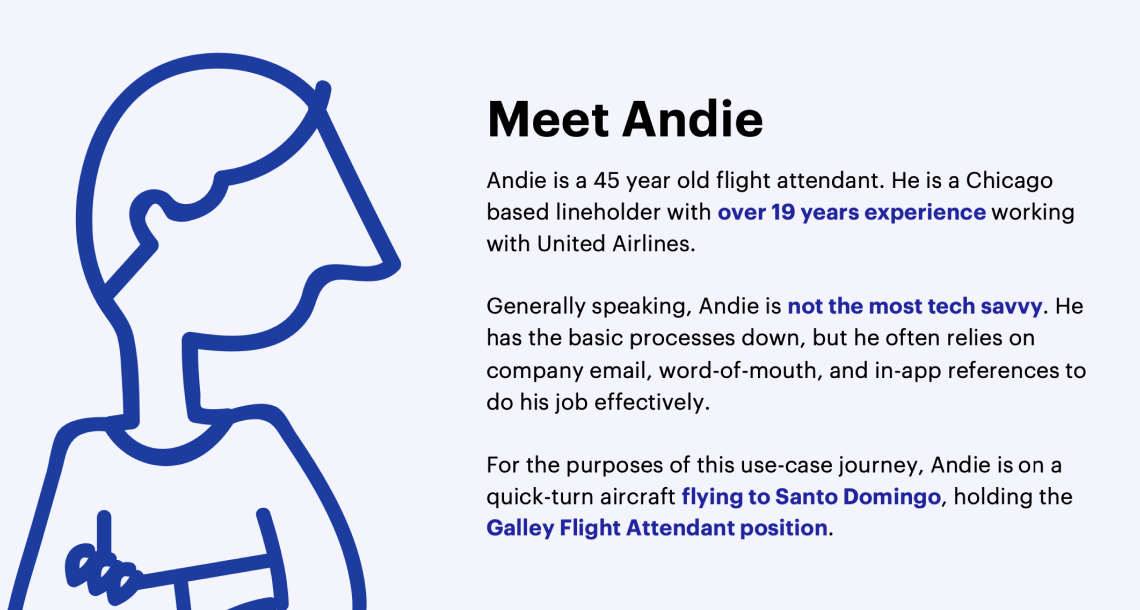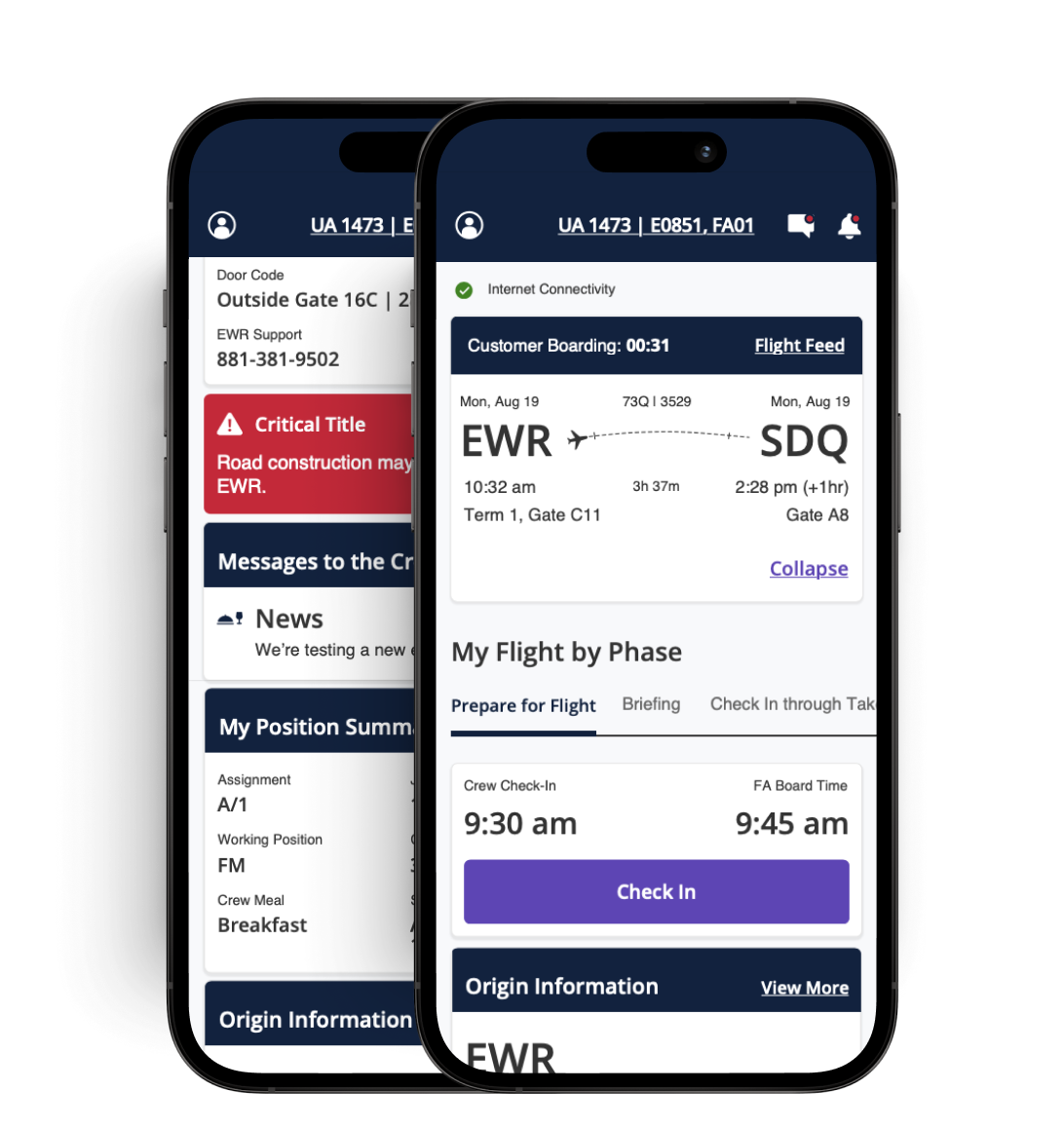
UNITED AIRLINES
Merging 30+ tools into one central experience for flight attendants
CHALLENGE
At the start of this engagement, United Airlines flight attendants relied on over 30 different apps to manage in-flight operations, customer interactions, and regulatory compliance. This fragmented system led to inefficiencies, reduced user satisfaction, and operational inconsistencies. Our multi-disciplinary team of creative and business experts partnered with United to create an integrated platform that provided a seamless, intuitive user experience while addressing key business needs.
The ultimate goal of this project was to place the flight attendants in the pilot seat (metaphorically), and to make it easier for them to transition from task to task.
DETAILS
A 12-week discovery and design initiative blending Design Thinking and Agile to define user-centered products. Through close collaboration, we aligned on experience goals, clarified scope, and prioritized features—delivering a 3-sprint near-term plan, long-term roadmap, wireframes, content strategy, product flows, and research insights.
Core outputs included:
Competitive and Market Research
User Testing Guide, Synthesis, and Readout
End-to-end journey map
3 User Personas (one primary to orient the golden path)
User Journey
Product Flow (with and without feature mapping)
High Fidelity Wireframes and Prototype
Product Roadmap + Recommended Sprint Plan
ROLE
Role / Design Director, Project Lead
Team / 1 Mid-Level Designer, 3 Content Designers, 1 Service Designer
Duration / 15 weeks

The project was kicked off with business stakeholder interviews, group interviews with flight attendants, and a 3-day workshop to collaboratively define the end-to-end user journey and establish foundational insights.
By the end of the week, we left with:
A shared understanding of the user journey
A prioritized list of user needs and business goals
Concept sketches for the integrated platform
Discovery
Collaboration and Ideation
End-to-End Journey Map
Mapping the Journey
Defining the
Primary Persona
We defined our user persona to keep ourselves focused on the moments that matter the most when diving into the user experience.

Hero Path (Ideal State)
We then identified the “hero path”, otherwise known as a golden or happy path. We used these points in the journey to align on what screen or section within the new app would be the best place to explore the user requirements and design against their needs in that moment.
Product Flow
We took the 8 apps and mapped the features and content at a high level to the future vision of the Link App. From there, we focused on the creation of a product flow, with the intention of mapping all concepts, features, and prioritized user stories into a unified app experience for the flight attendants.
Feature Mapping Product Flow
Simplified Product Flow

User Testing
We set out in the first round of user testing to understand if the current navigation, design patterns works with their working mental model. We also wanted to assess the perceived value of the designs.
After testing with 11 FAs individually, the team also conducted a card sorting exercise with the FAs to further pressure test the navigation structure.
Most flight attendants found a lot of positive value in having all of their tasks and resources accessible from a single location. However, people had differing opinions when it came to guessing where certain things could live throughout the app. To accommodate their needs, we created a structure that supports them by providing contextual information context.

Wireframes
We took high fidelity wireframes to leverage as a prototype in user testing session with flight attendants and focus group interviews to test the user experience for MVP.
A closer look at the details…
FLIGHT BY PHASE
From customer check-in to deplaning, and everything in between, users are able to view different tasks, tools, and resources based on what standard phase of the flight they are in.
TASK-BASED FLOWS
During interviews, flight attendants emphasized the importance of the tasks they’re assigned and the order in which those tasks are completed. For this reason, we prioritized a check-list interface to help users stay grounded in the flurry of tasks they have to complete.
FLIGHT TOGGLE
Flight attendants are not only given access to their current flight, but they can quickly toggle to the next leg of their flight.
FLIGHT DETAILS
Users are shown a quick snapshot of the flight details, including departure and destination information; the idea is that this would mirror what customers can see in their United Airlines guest app.
NAVIGATION
While the homepage is designed for all critical information needed at each moment, flight attendants can also navigate to aircraft details, service and supply inventory, and customer information.

Outcome
Orion is United’s product design system that was previously created, which would be leveraged to define the visual design for the United Link App. What you see to the right is an interpreted example of how Orion was recommended to be applied to the wireframes as they exist in their current state.
Today, to our team’s knowledge, United Airlines flight attendants are using a single source of truth for their flight-to-flight tasks thanks to this engagement.













